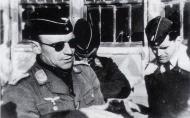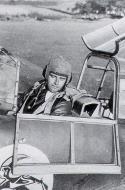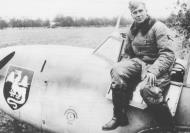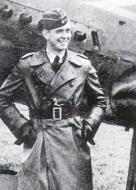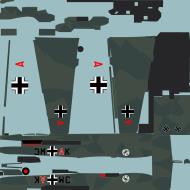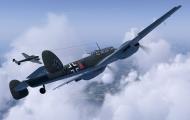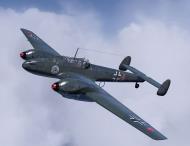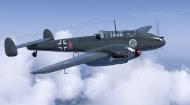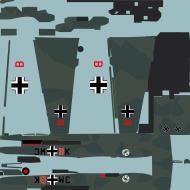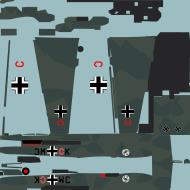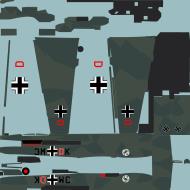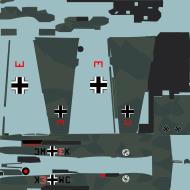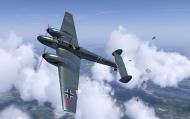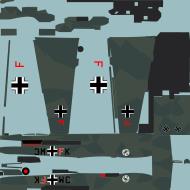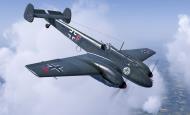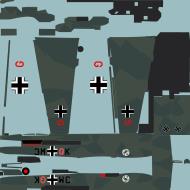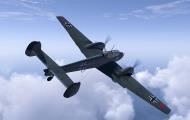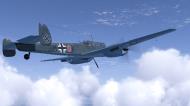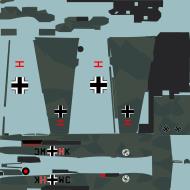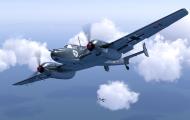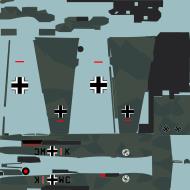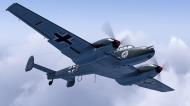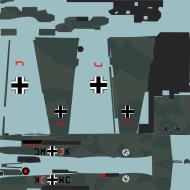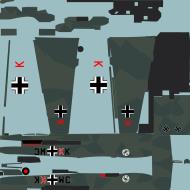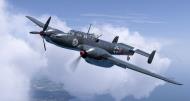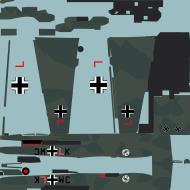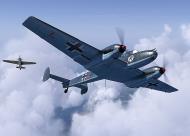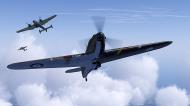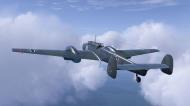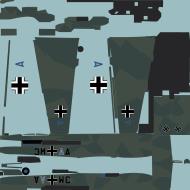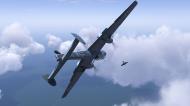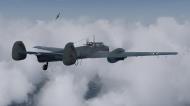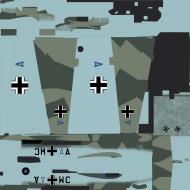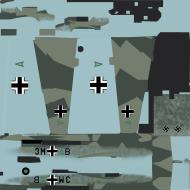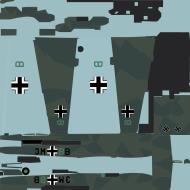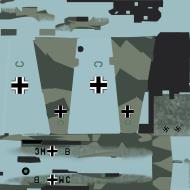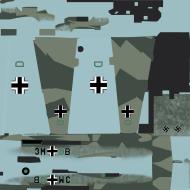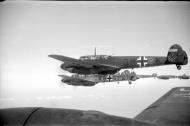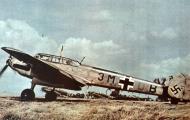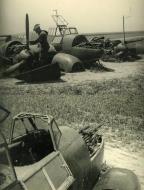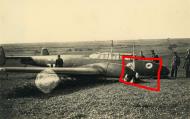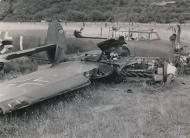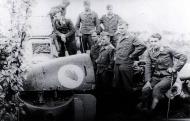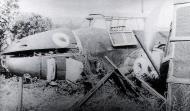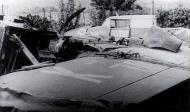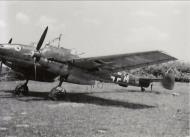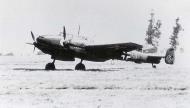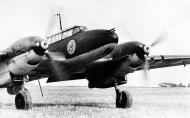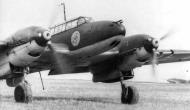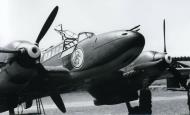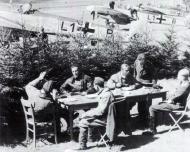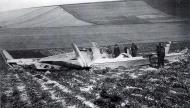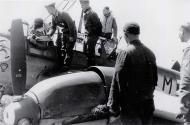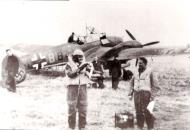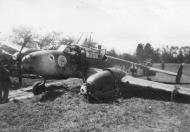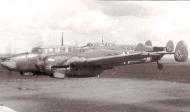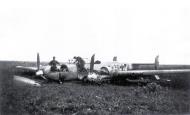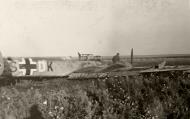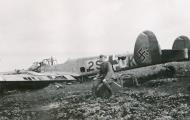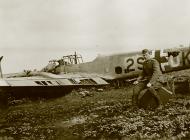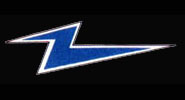
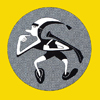 I Gruppe Zerstörergeschwader 2 - I./ZG2 code 3M+ and A2+
I Gruppe Zerstörergeschwader 2 - I./ZG2 code 3M+ and A2+
Messerschmitt Bf 110C Zerstorer Geschwader Stab ZG2 (3MAA) Wilhelm Schaefer shot down England 1940 01
Messerschmitt Bf 110C Zerstorer I./ZG2 (3M+ ) base crash landing 01
Photo 01: A crash-landed Bf 110D of I./ZG2 which has the later style light camouflage on the fuselage sides. The pilot appears to be having some difficulty extricating himself from the cockpit while his Bordfunker looks on. It must have happened near the base as ground crew are helping the pilot and it appears one of the landing gear gave wave during the landing.
Messerschmitt Bf 110C Zerstorer I./ZG2 (3M+ ) crash landing 01
Photo 01: Another view of a crash landed Bf 110 from I./ZG2. Note the variation in the hand emblem, and the 'Bernberger Jager' emblem beneath the cockpit.
Messerschmitt Bf 110C Zerstörer I./ZG2 01
Photo 01: A Bf 110C of I./ZG2 taxis, with another behind. The large unit emblem can be seen on the fuselage. Note the light-coloured spinner tips. Bf 110s of this unit saw heavy fighting over the central Channel area on 11 and 12 August 1940.
ZG2 luftwaffe pilot Eberhard Heinlein 01
Photo 01: Hptm. Eberhard Heinlein, Gruppen Kommandeur of 1./ZG2, left, in discussion with officers of his 1.Gruppe. On the extreme right is Gerhard Granz, Gruppenadjutant, who was shot down into captivity on 7 September 1940.
ZG2 luftwaffe pilot Gerhard Granz 01
Photo 01: Oblt. Gerhard Granz, Gruppenadjutant of I./ZG2, in the cockpit of his Bf 110. Granz was yet another Zerstorer pilot to spend most of the war in captivity when he was shot down on 7 September 1940.
Stab I Gruppe Zerstörergeschwader 2 - Stab I/ZG2
Messerschmitt Bf 110C4 Zerstorer Stab I./ZG2 (3M+BB) France 1940 flown by Oberleutnant Gerhard Granz and Feldwebel Willi Schubel Bordfunker both baled out of this aircraft W.Nr3246 on Sep 7TH, 1940 surviving and becoming POW's
Messerschmitt Bf 110C4 Zerstorer Stab I./ZG2 (3M+DB) France 1940
No Problem it's a Bf110C-4, Stab. I./ZG 2. Concerning the "D" colour it's more complicated: 1/ looks different on both picture. 2/ I don't know RLM number 3/ It's Emerald blue, means looks green and depends of fabrication batch, as usual with paints, and Blue is a very unstable colour under the sun!!! So you must write "Gr�nes D".
1 Staffel I Gruppe Zerstörergeschwader 2 - 1./ZG2 code 3M+
Messerschmitt Bf 110C Zerstörer 1./ZG2 (3M+AH) France 1940 01
Messerschmitt Bf 110C-4 1 Staffel I./ZG2 (3M+FH) France 1940.2 Staffel I Gruppe Zerstörergeschwader 2 - 2./ZG2 code 3M+
Messerschmitt Bf 110C Zerstörer 2./ZG2 (3M+BK) France 1940 00
Messerschmitt Bf 110C of 2./ZG2 Bf 110C, 3M+BK clearly carries the 'Bernberger Jager' emblem under the forward cockpit, and has solid camouflage down the fuselage sides. I.Gruppe of ZG2, like II./ZG76, appears to have retained the early style camouflage throughout the Battle of Britain.
Messerschmitt Bf 110C Zerstörer 2./ZG2 (3M+BK) France 1940 01
Photo 01: 3M+BK of 2./ZG2, showing the later style fuselage cross. The individual aircraft letter, B, is black outlined in white.
Messerschmitt Bf 110 Zerstörer 2./ZG2 (3M+_K) France 1940 01
Messerschmitt Bf 110C Zerstorer 2./ZG2 (3M+GK) W.Nr 2134 France 1940
Messerschmitt Bf 110E Zerstörer 2./ZG2 (3S+DK) crash landed Russia 01
Photo 01: Bf 110E of 2./ZG2 belly landed on the Russian Front. ZG2 spent only a short time on the Russian Front in mid 1942 before being disbanded and its personnel incorporated into other units. Note the rear fuselage band and the capped spinners.
3 Staffel I Gruppe Zerstörergeschwader 2 - 3./ZG2 code 2S+
Messerschmitt Bf 110E1 Zerstörer 3./ZG2 (2S+EL) Russia 1942
II Gruppe Zerstörergeschwader 2 - II./ZG2 code 3M and A2
Messerschmitt Bf 110 Zerstörer II./ZG2 (A2+ ) 01
Photo 01: Aircraft of II./ZG2 taxi out for take-off. Note that they carry the lighter camouflaged fuselage sides.
Geschwader Stab Zerstörergeschwader 2 - Stab ZG2
Messerschmitt Bf 110C Geschwader Stab ZG2 (3M+AA) pilot Wilhelm Schaefer shot down England Sep 4 1940
Photo 01: Also brought down on 4 September was 3M+AA flown by Oblt. Wilhelm Schaefer, Geschwaderadjutant of ZG2, with Uffz. Heinz Bendjus as Bordfunker.
Pilots JG142.2 pilot Wilhelm Schaefer 01
Photo 01: Pilot Wilhelm Schaefer, shown here during his time with II./JG142. On the early Bf-109 behind him his personal emblem of a single yellow lightning flash can be seen.
Messerschmitt Bf 110C Geschwader Stab ZG2 (3M+AA) Friedrich Vollbracht WNr 2116 France 1940
4 Staffel II Gruppe Zerstörergeschwader 2 - 4./ZG2 coded 3M+
Messerschmitt Bf 110C Zerstörer ZG2.4 (3M+KH) crash landing 01
Photo 01: Three views of a crash landed Bf 110, 3M+KH, of 4./ZG2, showing the red hand on a white circle emblem of I./ZG2.
Formed 26 Jun 1940 at Freiburg from I./ZG52 with:
Stab II./ZG2 from Stab I./ZG52
4./ZG2 from 1./ZG52
5./ZG2 from 2./ZG52
6./ZG2 from 3./ZG52
For example aircraft codes would of ended up like so:
Stab I./ZG52 coded (A2+AB) became Stab II./ZG2 coded (A2+AB)
1./ZG52 coded (A2+AH) became 4./ZG2 coded (A2+AH)
2./ZG52 coded (A2+AK) became 5./ZG2 coded (A2+AK)
3./ZG52 coded (A2+AL) became 6./ZG2 coded (A2+AL)
Guyancourt France Map
Eberhard Heinlein
Units: Kdr I/ZG-2 (8/40 Berck-sur-Mer, Acting Kdr II/ZG-2 (8/40)
Awards: Destroyer Operational Clasp
Known Aircraft: Bf 110C-2
Remarks: Channel pilot. Replaced Hptm Ott as Kdr.
Wilhelm Schaefer
A Zerstorer pilot's Battle of Britain tail
by Wilhehn Schaefer, ZG 2Wilhelm Schaefer was already an experienced pilot by the time he entered the Battle of Britain. Previously with Zerstorergeschwader 26 with his senior officer, Oberstleutnant Friedrich Vollbracht, he moved to Zerstorergeschwader 2 when Vollbracht was posted to that unit as Commanding Officer of the Geschzuader. Schaefer took up post as Adjutant to Vollbracht.
On 11 August 1940 a large force of Messerschmitt Bf 110s flew escort to a bomber formation headed for Portland. Schaefer describes this eventful mission:
On this day, shortly before 10 a.m., all of the available Me-110s of 1. and II. Gruppen of Zerstorer Geschwader 2 formed up over the Cherbourg peninsula to escort a large formation of Junkers 88s and Heinkel Ills on an attack on the southern English port of Portland.Altogether there were more than 150 aircraft flying towards Portland, of which 60 were Messerschmitts. After arriving at the target they (the Messerschmitts) formed an 'Abwehrkreis' (defensive circle) above the bombers, thus allowing them to complete their task: to destroy the fuel installations in the harbour.
In this way the Me 11 Os attracted the full force of the English attack consisting of 74 Spitfires and Hurricanes flying above them. The German fighters lost six aircraft in this attack.
''I'll now supplement tills with my own personal experience. The' Stab' (Staff Flight) machines of ZG 2, flown by Gescbwader kommodore Oberstleutnant Friedrich Vollbracht, and Geschwaderadjutant Oberleutnant Wilhelm Schaefer with Bordfunker Oberleutnant de Wilde, flew this mission with the Staff Flight of 1. Gruppe, ZersfOrergeschwader 2 under Major Otto
Within this formation I flew on the left side of the Kommodore's machine. When the English aircraft attacked, a Hurricane from the right got into position right behind him. I got into a good firing position and, with a smoking engine, he dived steeply downwards.
After a combat lasting about an hour, I flew alongside the Kommodore as the whole unit headed for the French coast. We had just passed the midway point in the Channel when there was an explosion behind me. My oxygen system had failed and a glance behind me showed that my Bordfunker, Oberleutnant de Wilde, had been wounded. Because I couldn't work out the cause of the explosion - Flak? Enemy fighter? Ammunition exploding? - I set the aircraft into a low dive over the Channel.
At this moment there was a second explosion. The cockpit canopy and other parts blew away. I felt I had been wounded in the head and arms. Obit. de Wilde appeared badly wounded. The plane dived at high speed towards the water. At this stage, I still hoped that we could reach the French coast, to be able to help Obit. de Wilde, should he still be alive. Baling out was out of the question.
In order to reduce the speed of the aircraft, I put the propellers into 'dive'. They had, however, been damaged by the second explosion, so I was diving almost vertically towards the water. It was the worst moment in my life up to that point.With all my strength I succeeded in coming out of the dive a few metres above the water. Because of the damaged propellers straight flight was not possible, so I decided at the last minute to land on the water. Standard instructions for such a landing in an Me 110 were somewhat vague. The pilot was advised to release the cockpit canopy, unharness himself, to avoid collision with the dashboard, and roll forward out of the cockpit. In my case the Me 110 didn't respond in the standard way. It landed on a swell, the canopy was open, and I was free from my harness. I didn't roll out of the cockpit, however, but hit my head on the dashboard. How long I remained unconscious, I do not know. When I came to, however, most of the aircraft was already under water. A quick glance into the Bordfunker's position showed me that nothing more could be done. Obit. De Wilde was dead.
I jumped into the sea and immediately sank like a stone because I hadn't released my parachute. Luckily I was able to do this as I sank. When I came to the surface once more, the aircraft had gone under, together with de Wilde. I can't describe my feelings at that time.
All was not lost. I noticed a few metres away the coloured marker which was standard equipment for flights over water, and which had broken off on impact. It would be a life-saver since it marked with a yellow/green light the place of 'landing' so that I might be saved.
The rescue operation ran almost like a fairy tale. A son of Generaifeldmarschall von Blomberg, Major Axel von Blomberg, was standing at this time on the cliffs near Cherbourg and saw through his binoculars an aircraft returning from England and falling into the sea, then disappearing. He registered the direction and distance (about 25 kilometres) on his map and then drove in his car to the nearest fighter airfield in order to put into operation a rescue plan. The Me 109s stationed there had returned shortly before the battle and had to be refuelled and made ready for the next mission. The Station Commander was not particularly keen on the proposed plan but eventually agreed to it.
In the meantime I swam for almost four hours in the Channel, always under the false impression that I could reach the French coast. I didn't know that the Gulf Stream was taking me in the opposite direction! During this long period many German aircraft flew overhead, though not one gave me any recognition. As I felt the onset of tiredness, together with a bullet wound in my upper left arm that was becoming increasingly painful, I suddenly heard the noise of engines and three Me I09s flew directly towards me. They waggled their wings - a sign of recognition - and one flew off back while the other two remained in formation near me. After another half hour or so a German maritime emergency aircraft, a Heinkel 59, arrived from its base in Cherbourg. It landed nearby and rescued me from the water.
The cold had got to me so much that I was unable to climb onto the raft of the He 59 without help. I had to be hauled into the cabin. Someone gave me a schnapps to drink and I was then informed that I might have to jump back into the water if they couldn't start the engines; they weren't in 100 per cent working order!
In spite of a happy landing in Cherbourg I was taken to the local hospital to 'thaw out' and then, the next day, was brought before the Kommodore, since I had been reported as 'missing' the previous day. That day, once again at my unit's base at St. Aubin, the story of my shooting down was broadcast live on German radio and heard by my family back home.
A few days later I had the opportunity to thank personally Major Axel von Blomberg for his help. For me, the rescue came out of a no-hope situation.
Oberleutnant de Wilde had made a particular request to fly on that mission of 11 August 1940. His fate was particularly sad for me. Wilhelm Schaefer did not fly again until 4 September 1940. This was another eventful flight, which he describes thus:
On the evening of 3 September the mission orders of the Geschwaderstab of Zerstorergeschwader 2 for the following day, Wednesday 4 September, were issued. As well as the Kommodore, Oberstleutnant Friedrich Vollbracht, and myself as Geschwaderadjutant, the Gruppenkommandeuren of I. and II. Gruppen of ZG 2 were in attendance. Our base was Berck-sur-Mer on the Normandy coast, south of Boulogne.
Both Gruppen had been detailed to fly escort to bomber formations. The targets were aircraft industry works in the south-west and west of London.
I was not down to fly this mission, as my aircraft had been shot down into the Channel on 11 August between Portland and Cherbourg, and a replacement still had not arrived.
On the morning of 4 September, as the aircraft of I. Gruppe were started up, and II. Gruppe were moving to their take-off position, the Geschwaderkommodore suddenly gave me the 'green light' to take part in the mission in his machine, in his place.
With my Bordfunker, Unteroffizier Heinz Bendjus, I arrived at the airfield ten minutes later, and found that the Kommodore's machine had one wing uncovered. As both Gruppen had already taken off there was no time to warm up the engines. Already, on take-off, there were problems, as the tail unit was malfunctioning and the cold engine was not functioning properly.
I was not successful in my hope of catching up the rest of my unit before the English coast was reached, and so my flight was a solo effort to England. . .
From afar I could see that the Me 110s were caught up in a heavy dogfight. Although my left engine was still not functioning fully, I hoped in the meantime to link up with my Geschwader on the return flight. As a result of my stuttering engine I was neither high enough nor fast enough to catch up with my returning Geschwader and shortly afterwards was attacked by several Spitfires. As my chances in the forthcoming combat were slim, I took my first chance to dive towards the coast - that was a mistake. As I flew over the coast, coming towards me from the Channel were two English fighters that immediately engaged me in a low-level combat. Fired at from both sides, but without success, I was hoping that they would soon have to break off combat due to low fuel, when a third fighter appeared above me in a firing position, and turning, the full side of my Messerschmitt presented a good target. In spite of several hits, I was still able to control the aircraft, until the left engine failed and I could no longer do so. In order not to crash in flames, I shut off both engines, and carried out a belly-landing in a meadow. The place of the force-landing was Mill Hill, Shoreham Downs; the time was 13:50 hours on 4 September 1940. With that, the active war service for my Bordfunker and myself ended.
I myself was not wounded, Unteroffizier Bendjus was slightly wounded. Our aim to set our aircraft on fire was not to be. We were soon 'greeted' by Home Guard, and transported into captivity in a nearby village. On the way we were met by an English officer pilot, who claimed to have shot us down. He apologised for not being able to take us for a drink in the officers' mess with him.
The wife of the village policeman, in whose kitchen we spent the first night, provided us with hot tea, toast, fish and sausage, for which I am thankful even to this day. Unfortunately I don't have the names of these wonderful people, so I wasn't able to contact them post-war.
Units: JGr Schule 1, JG-52, I./ZG-2
Awards: Fighter & Destroyer Operational Clasps
Known Aircraft: Bf 109D, Bf 110 in ZG-2
Remarks: POW in September, 1940, shot down over England. Interned in Canada. Retired Bundeswehr Oberst. Deceased 7 July, 2000. Jager Blatt article.
Friedrich Vollbracht
Units: Kdr II./ZG-142 (1/39), Kdr II./ZG-26 (5/39 Werl), Kdr ZG-2 (8/40 Toussous)
Awards: RK(10/13/40), EK 1 & 2, Destroyer Operational Clasp
Known Aircraft: Bf 109D in ZG-142 & 26, Bf 110C-2 & Bf 110C-4 WNr 2116 (lost 9/40) in ZG-2
Remarks: Channel pilot. Kdr Erg/Z Grp-210 in September, 1940. His Wk# 2116 '3M+AA' was shot down on 4 September, 1940 when flown by Oblt Wilhelm Sch�fer. 2 victories in WWI and 2 victories in WWII. Deceased.
Luftwaffe pilot Walter Nowotny 258 kills
Luftwaffe pilot Theodor Weissenberger 208 kills
Luftwaffe pilot Heinz Bar 175 kills
Luftwaffe pilot Franz Schall 133 kills
Luftwaffe pilot Rudolf Rademacher 126 kills
Luftwaffe pilot Adolf Galland 104 kills
Luftwaffe pilot Hermann Buchner 58 kills
Luftwaffe pilot Erich Hohagen 50 kills
Luftwaffe pilot Rudolf Sinner 39 kills
Luftwaffe pilot Ernst-Wilhelm Modrow 32 kills
Luftwaffe pilot Richard Altner 25 kills
Luftwaffe pilot Gunther Wegmann 21 kills
Luftwaffe pilot Wolfgang Schenck 18 kills
Luftwaffe pilot Franz Holzinger 10 kills
Luftwaffe pilot Helmut Lennartz 10 kills
Luftwaffe pilot Alfred 'Bubi' Schreiber 9 kills
Luftwaffe pilot Eduard Schallmoser 3 kills
Luftwaffe pilot Wilhelm Batel 1 kills
Luftwaffe pilot Joachim Fingerlos 1 kills
Bibliography: +
- Campbell, Jerry L. Messerschmitt BF 110 Zerstörer in Action. Carrollton, Texas: Squadron/Signal Publications, Inc., 1977. ISBN 0-89747-029-X.
- Caldwell, Donald and Richard Muller. The Luftwaffe over Germany: Defence of the Reich. London: Greenhill Books, 2007. ISBN 978-1-85367-712-0.
- Ciampaglia, Giuseppe. 'Destroyers in Second World War'. Rome: IBN editore, 1996. ISBN 88-86815-47-6.
- Deighton, Len. Fighter: The True Story of the Battle of Britain. London: Pimlico, 1996. ISBN 0-7126-7423-3.
- de Zeng, H. L., D. G. Stanket and E. J. Creek. Bomber Units of the Luftwaffe 1933-1945: A Reference Source, Volume 2. London: Ian Allan Publishing, 2007. ISBN 978-1-903223-87-1.
- Donald, David, ed. Warplanes of the Luftwaffe. London: Aerospace, 1994. ISBN 1-874023-56-5.
- Geust, Carl-Fredrik and Gennadiy Petrov. Red Stars Vol 2: German Aircraft in the Soviet Union. Tampere, Finland: Apali Oy, 1998. ISBN 952-5026-06-X.
- Hirsch, R.S. and Uwe Feist. Messerschmitt Bf 110 (Aero Series 16). Fallbrook, California: Aero Publishers, Inc., 1967.
- Hooton, E.R.Luftwaffe at War; Blitzkrieg in the West: Volume 2. London: Chervron/Ian Allan, 2007. ISBN 978-1-85780-272-6.
- Hooton, E.R. Luftwaffe at War; Gathering Storm 1933-39: Volume 1. London: Chervron/Ian Allan, 2007. ISBN 978-1-903223-71-0.
- Ledwoch, Janusz. Messerschmitt Bf 110 (Aircraft Monograph 3). Gdańsk, Poland: AJ-Press, 1994. ISBN 83-86208-12-0.
- Likso, T. and D. Canak. Hrvatsko Ratno Zrakoplovstvo u Drugome Svjetskom Ratu (The Croatian Airforce in the Second World War). Zagreb, 1998. ISBN 953-97698-0-9.
- Mankau, Heinz and Peter Petrick. Messerschmitt BF 110/Me 210/Me 410: An Illustrated History. Atglen, PA: Schiffer Publishing, 2003. ISBN 0-7643-1784-9.
- Murray, Willamson. Strategy for Defeat: The Luftwaffe 1935-1945. Maxwell AFB, Al: Air Power Research Institute, 1983. ISBN 0-16-002160-X.
- Mackay, Ron. Messerschmitt Bf 110. Wiltshire, UK: The Crowood Press, 2000. ISBN 1-86126-313-9
- Middlebrook, Martin. The Peenemunde Raid: The Night of 17-18 August 1943. Barnsely, UK: Pen & Sword Aviation, 2004. ISBN 1-84415-336-3.
- Munson, Kenneth. Fighters and Bombers. New York: Peerage Books, 1983. ISBN 0-907408-37-0.
- Price, Alfred. Messerschmitt Bf 110 Night Fighters (Aircraft in Profile No. 207). Windsor, Berkshire, UK: Profile Publications Ltd., 1971.
- Savic, Dragan and Boris Ciglic. Croatian Aces of World War II (Osprey Aircraft of the Aces - 49). London: Oxford, 2002. ISBN 978-1-84176-435-1.
- Treadwell, Terry C. Messerschmitt Bf 110(Classic WWII Aviation). Bristol, Avon, UK: Cerberus Publishing Ltd., 2005. ISBN 1-84145-107-X.
- Van Ishoven, Armand. Messerschmitt Bf 110 at War. Shepperton, Surrey: Ian Allan Ltd., 1985. ISBN 0-7110-1504-X.
- The Messerschmitt Bf 110 in Color Profile 1939-1945 John Vasco and Fernando Estanislau by Schieffer Publications. ISBN:0-7643-2254-0
- Wagner, Ray and Heinz J. Nowarra. German Combat Planes: A Comprehensive Survey and History of the Development of German Military Aircraft from 1914 to 1945. New York: Doubleday, 1971.
- Weal, John. Messerschmitt Bf 110 Zerstörer Aces World War Two. London: Osprey, 1999. ISBN 1-85532-753-8.
Magazine References: +
- Airfix Magazines (English) - http://www.airfix.com/
- Avions (French) - http://www.aerostories.org/~aerobiblio/rubrique10.html
- FlyPast (English) - http://www.flypast.com/
- Flugzeug Publikations GmbH (German) - http://vdmedien.com/flugzeug-publikations-gmbh-hersteller_verlag-vdm-heinz-nickel-33.html
- Flugzeug Classic (German) - http://www.flugzeugclassic.de/
- Klassiker (German) - http://shop.flugrevue.de/abo/klassiker-der-luftfahrt
- Le Fana de L'Aviation (French) - http://boutique.editions-lariviere.fr/site/abonnement-le-fana-de-l-aviation-626-4-6.html
- Le Fana de L'Aviation (French) - http://www.pdfmagazines.org/tags/Le+Fana+De+L+Aviation/
- Osprey (English) - http://www.ospreypublishing.com/
- Revi Magazines (Czech) - http://www.revi.cz/
Web References: +
- Wikipedia.org - https://en.wikipedia.org/wiki/Messerschmitt
 Editor for Asisbiz: Matthew Laird Acred
Editor for Asisbiz: Matthew Laird Acred
If you love our website please subscribe to our YouTube video channel
Please donate so we can make this site even better !!

